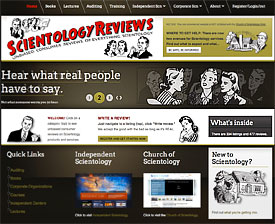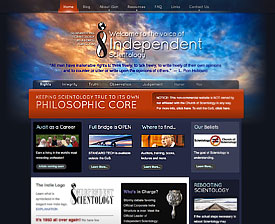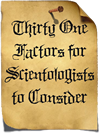|
I received the following letter yesterday from James R. Lewis, a religious scholar who has written several papers on the Church of Scientology. I am publishing his article in full without alteration. - Thoughtful
18 January 2011
An Open Letter to:
Scientologists, Ex-Scientologists, and Critics of the Church of Scientology
James R. Lewis
[This letter may be re-posted, as long as it is reproduced in full, without alteration. JRL]
I am an academician and a specialist in the field of new religious movements. Particularly during my early career, much of my research focused on the alternative religions that have been labeled “cults,” and on the controversies in which they have been involved. Though I have sometimes been criticized as a “cult apologist,” in point of fact my views on such groups are nuanced and often critical (in this regard, refer, for example, to my online essay, “Safe Sects?” http://www.religioustolerance.org/safe_sec.htm). It should especially be noted that my views on these matters generally conform to the consensus views of mainstream scholars of new religions (i.e., my views are not unique to me). As an academician, my primary audience has been other academicians. Thus, over the years, I have ignored the often ad hominem criticisms that have been leveled against me online by individuals involved in the cult controversy.
However, two things have happened in recent years that have prompted me to address these matters – particularly as they involve the Church of Scientology (CoS) – in a more personal way: (1) My edited collection on Scientology, published by Oxford University Press in 2009, had the effect of raising my profile in the cult controversy. (2) As the result of the defection of large numbers of upper level Scientologists, the Church of Scientology has received increasing media attention – which has had the effect of calling further attention to my Scientology anthology. Thus it seems that circumstances have been pushing me to set forth some of my views on CoS – both academic and personal – in a public way. Hence the current “open letter,” which I hope will be widely distributed (and not quoted out of context).
I should preface my remarks by noting that academicians are ill-suited to participate directly in public controversies, in part because, as a group, we do not think in sound bites. Also, in almost any controversy, all sides of the conflict tend to boil issues down to black-and-white, good-vs.-evil terms, and sometimes adopt a belligerent attitude of “you’re either for us or against us.” I anticipated this reaction when, in the introduction to the Scientology anthology, I asserted that “This volume will...likely end up pleasing no one engaged in the Scientology/anti-Scientology conflict....”
Predictably, critics trashed the book as a public relations exercise, “obviously” paid for by the Church of Scientology. However – as any informed observer could easily have anticipated – CoS hated the collection, particularly the Xenu chapter, which one of my former contacts in the Church characterized as “blasphemy.” Another chapter described CoS’s attempts to suppress scholarship that the Church viewed as presenting Scientology in a negative light. And there were other critical evaluations peppered throughout the text. But, because the book as a whole was not a negative exposé, many anti-Scientologists dismissed the whole collection as a “whitewash.” For its part, the Church of Scientology soon stopped communicating with me altogether, meaning that I have probably been re-categorized as an SP as a direct result of my book.
In this Open Letter, I will not rehearse the social-scientific analysis of the cult controversy that is the consensus view of mainstream new religion researchers. Rather, I will focus the discussion on my evolving understanding of the Church of Scientology.
Neither I nor the great majority of new religions specialists view ourselves as defenders of groups like Scientology. Rather, we are interested in understanding social-psychological processes and the dynamics of social conflict. The fact that many of our analyses undermine the more simplistic accusations leveled against controversial new religions makes it appear to critics caught up in black-and-white thinking that we have made a conscious choice to defend “cults.” However, to the extent that we have chosen to defend anything, we understand ourselves as defending good science against bad science, and, in some cases, as defending religious liberty against the threat to religious liberty posed by the least sophisticated forms of anti-cultism.
My orientation to the study of new religions is informed by the fact that, for three years in my early twenties, I was a member of a controversial new religion, Yogi Bhajan’s 3HO (I have recently described my defection from 3HO in an online article, “Autobiography of a Schism” http://www.uni-marburg.de/fb03/ivk/mjr/pdfs/2010/articles/lewis_2010.pdf). Though I held certain negative feelings toward my former organization after my exit, these feelings were on par with the feelings one might have about one’s ex-spouse following a divorce (i.e., bad, but not extraordinary). Additionally, I had a number of positive experiences during my term of membership in 3HO that served to balance out my negative experiences.
When I first became interested in the cult controversy as a subject of academic inquiry in the mid 1980s, I was struck by the uniformly negative picture painted by “deprogrammed” ex-members of controversial groups – a picture that contrasted sharply with the mixed evaluation I had formed of 3HO. I suspected these negative evaluations were shaped, at least in part, by the deprogramming experience itself. So I surveyed former members – both deprogrammed and non-deprogrammed – and found that the data strongly supported my hypothesis. (In this regard, refer, for example, to my “Apostates and the Legitimation of Repression,” Sociological Analysis 49:4. 1989, and my “Reconstructing the ‘Cult’ Experience,” Sociological Analysis 42:2. 1986. Parts of these papers reappeared in my Legitimating New Religions. 2003.)
I first made contact with the Church of Scientology during this period for the purpose of locating former Scientologists to whom I could send questionnaires (this never worked out because of CoS’s ill-conceived policy of disconnecting itself from ex-members). A few years later, the Scientology organization became enthusiastic about the conclusions I had reached, and later referred to my research in some of its legal cases – in large part due to the fact that this research called into question the hostile testimony of deprogrammed former Scientologists.
CoS subsequently decided that I was an ‘ally’ (a quasi-technical term within the universe of exotic Church jargon). From that point forward, I was sometimes (but not frequently) asked to write letters of support, usually in response to specific conflicts. I was also once asked to testify as an expert witness in a Scientology court case (to which I agreed, though I never did testify). Additionally, during the years I lived in Santa Barbara, California, I attended various Church events, particularly events at the Hollywood Celebrity Center. Finally, during the ten years I lived in the Midwest, I regularly invited Scientologists from the Chicago Org to speak in my university classes. (As part of my approach to teaching courses on new religions, I invited representatives of many different groups to speak in my classes – not just Scientologists.)
I was, of course, aware of CoS’s unpleasant history, particularly its often vicious attacks on perceived enemies. But, as I got to know Scientologists on a personal basis, I was informed – and came to believe – that the illegal and truly onerous attacks had been discontinued following the dissolution of the Guardian’s Office in 1983. (Unfortunately, the systematic harassment of high-profile ex-members and other critics has become de rigueur in recent years.) And while I disliked certain aspects of Scientology – particularly certain aspects of the Scientology organization – my personal experiences with Scientologists over the course of the past two dozen years have been generally quite positive. As a result of my recent book and as a result of this letter, they may never speak to me again, but I still like and respect almost everyone I knew within the Church.
One aspect of the organization that particularly impressed me was the Church’s social outreach activities, such as the Literacy Crusade and Criminon. Though often dismissed by critics as “front groups,” or as elaborate PR exercises, it is clear that, at Source, these activities are serious enterprises. At several junctures over the years of my acquaintance with CoS, I even requested support for undertaking an academic study of these enterprises. These requests were always denied (for which, in hindsight, I am exceedingly grateful).
I was not prompted to re-think my basic evaluation of the Church of Scientology until relatively recently. This came about as a consequence of several different factors:
(1) The defection of large numbers of long-time, high-ranking Scientologists, who reported intensive abuse at the highest levels of the Church. I am aware that CoS’s position on this has been to deny everything, and to accuse these ex-members of conspiring to concoct a negative picture of events. I find the official response unconvincing.
(2) The sacking of Heber Jentzsch. I knew Heber from when I first began to communicate with CoS in the mid 1980s. I respected him and came to regard him as someone I could trust. Retrospectively, I can now see that my evaluation of Heber significantly shaped my evaluation of the Church. So when he was taken off the front lines and consigned to some dungeon (figuratively speaking) in Gilman Hot Springs, it served to confirm, to my mind, what the high-ranking defectors were saying.
(3) The marketing of “new editions” of L. Ron Hubbard’s basic works. New, slightly “corrected” editions of Hubbard’s basic books have been issued, and Scientologists have been asked to purchase as many sets of volumes as possible so that complete sets can be donated to libraries across the globe. This has been done in the name of the utopian ideal of “clearing the planet.” But placing books in libraries seems an ill-conceived strategy for spreading any sort of message in a digital age. I was a guest at a Scientology workshop not too many years ago where I observed the very hard-sell tactics used to unload these multi-volume sets. It was transparent that this was a fund-raising ploy rather than an effective strategy for disseminating the message. Though I know Scientology has regularly been accused of using unethical methods for raising money, I felt that this was a particularly disingenuous tactic – and yet another symptom of the dysfunctionality of the Church’s top leadership.
This Open Letter is not an apology for anything I have written in the past on Scientology or on the cult controversy. I stand by, and am quite happy with, my body of work up to this point. Rather, in light of new information I have been receiving on the Church of Scientology, there are certain aspects of my scholarship that I would like to clarify and supplement as they bear on the current controversy.
In the first place, I should say that the only article-length paper I have ever written on CoS is my chapter on the growth of the Church in the Scientology anthology. In that piece, I criticized the claim that Scientology was the “fastest growing religion in the world,” but I also painted a picture of an expanding organization enjoying healthy growth. Though the statistics I collected (from the U.S., the U.K., Australia, Canada, and New Zealand) did not go beyond 2001, more recent data from the 2006 New Zealand and Australian censuses have continued to support this picture.
However, current events have completely overturned my evaluation of the CoS as a rapidly expanding religion. The relatively recent defection of large numbers of long-time, high-level Scientologists – some of the organization’s most experienced administrators and others with expertise in delivering the highest levels of Scientology technology – bodes poorly for the future of the Church. In particular, the pattern of solid growth I analyzed just a few years ago seems suddenly to have ground to a halt.
According to the pseudonymous ‘Plockton,’ who claims to have contacted ARIS (American Religious Identification Survey) researchers directly, the ARIS estimate for the number of Scientologists in the U.S. for 2008 was 25,000. (I referred to ARIS data in my chapter on the growth of Scientology.) This contrasts sharply with the 55,000 figure from the 2001 ARIS survey. (“2008 ARIS Study on Scientology Membership in US – Important Data.” Posted March 28, 2009 at: http://ocmb.xenu.net/ocmb/viewtopic.php?t=30372.) The drop in total numbers was likely less dramatic than these figures indicate (due to sampling issues discussed by Plockton in his posting).
In 2011, there will be new national censuses in the UK, Canada, New Zealand, and Australia, all of which will produce figures for total numbers of self-identified Scientologists. So by 2012, it will be relatively simple to contrast these numbers with prior census data. The figures derived from these comparisons will indicate whether membership in the Church of Scientology is growing or declining. Assuming the latter, these statistics should decisively refute David Miscavige’s claim that, under his leadership, CoS has become “the fastest growing religion in the world.”
Secondly, I have seen my research on former members of controversial new religions misrepresented. To clarify what should already have been transparent: The central point of comparison in my several articles on new religion apostates was between deprogrammed ex-members and other ex-members who left their respective movements on their own, without outside intervention. As mentioned earlier, I found a highly significant difference in the post-involvement attitudes of these two sets of apostates, a difference that called into question the veracity of statements made by deprogrammed ex-members about the religious groups to which they had belonged. My questionnaire data had nothing to say about individuals who defected without this kind of an intervention, except that they were likely more objective about their membership period than their deprogrammed counterparts. So, to be perfectly clear: anyone who cites my conclusions about deprogrammees as a way of dismissing the testimony of voluntary defectors – including the testimony of individuals who left the Church of Scientology – is either consciously misrepresenting my work or stupid.
Finally, another criticism leveled against the Scientology anthology was that it should have included a chapter on ex-Scientologists, and perhaps another chapter on the Freezone. I think this is an appropriate critique. I will therefore be undertaking systematic research on former Scientologists and on the Freezone – research that will be reported in future publications. If any ex-CoS members reading this Open Letter think they might be interested in participating in this project, please contact me at:
This e-mail address is being protected from spambots. You need JavaScript enabled to view it
.
James R. Lewis
|

 An Open Letter from James R. Lewis
An Open Letter from James R. Lewis

 "Scientology has been taken over by a self-appointed dictator, David Miscavige, who has turned the Creed of the Church of Scientology, the Code of a Scientologist, and the Credo of a True Group Member on their heads and instituted the virtual practice of Reverse (Black) Dianetics..."
"Scientology has been taken over by a self-appointed dictator, David Miscavige, who has turned the Creed of the Church of Scientology, the Code of a Scientologist, and the Credo of a True Group Member on their heads and instituted the virtual practice of Reverse (Black) Dianetics..." 
Comments
This famously lead him to defend Aum Shinrikyô after the sarin attack in Tokyo, indicating they had been the victim of government prosecution. He based his defence on the "sincerity" and "honesty" of the Aum representatives he had interviewed, apparently disregarding the possibility that such leaders could lie. His research on Scientology should be understood accordingly.
A general critique of the stance of stance on testimonies from former members of scholars on general and Lewis in particular:
http://griess.st1.at/gsk/fecris/warsaw/Kent EN.pdf
A rather scathing review of the role of cult apologists in the wake of the Aum Shinrikyô gas attack in Tokyo, discussing Lewis' research in particular:
http://eprints.lancs.ac.uk/14563/1/nr.2000.3.2.pdf
RSS feed for comments to this post